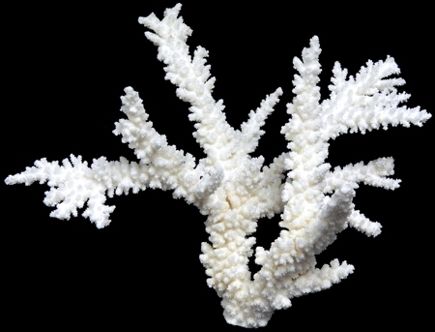A 7 to 10" Branch Coral cluster OUT OF STOCK
One Branch Coral cluster measuring 7 to 10 inches.
Orders usually process within 2 to 5 business days.
Make Your Selections and Shipping Preference. We Will Email You the amount of the Shipping Cost. When you receive the shipping cost go back into Shells-of-Aquarius.company and click into Purchase Shipping Label. There you will find UPS or USPS. Click into the option you decided on and make your payment. Your order will ship when shipping payment is received.
Email: ja1@mindspring.com
Acropora florida is a species of acroporid coral found in the southwest and northern Indian Ocean, the central Indo-Pacific, Australia, Southeast Asia, Japan and the East China Sea, Cook Islands and the oceanic west Pacific Ocean. It can be found in shallow reefs on the reef tops, walls and slopes to depths of 99 feet.
Acroporid Coral is a family of small polyped stony corals in the phylum Cnidaria. The name is derived from the Greek "akron" meaning "summit" and refers to the presence of a corallite at the tip of each branch of coral.
corallite is the skeletal cup, formed by an individual stony coral polyp, in which the polyp sits and into which it can retract. The cup is composed of aragonite, a crystalline form of calcium carbonate, and is secreted by the polyp. Corallites vary in size, but in most colonial corals they are less than an inch in diameter.
Colonies of Acropora florida consist of thick upright, and sometimes horizontal, branches growing from a sprawling or encrusting base. There are side branches and small branchlets which resemble knobs. The corallites are evenly spread. The color of this coral varies, and may be pinkish-brown or some shade of green.
Acropora florida is a zooxanthellate species of coral. It obtains most of its nutritional needs from the symbiotic dinoflagellates that live inside its soft tissues. These photosynthetic organisms provide the coral with organic carbon and nitrogen, sometimes providing up to 90% of their host's energy needs for metabolism and growth. Its remaining needs are met by the planktonic organisms caught by the tentacles of the polyps.
Zooxanthellae are photosynthetic organisms, which contain chlorophyll a and chlorophyll c, as well as the dinoflagellate pigments peridinin and diadinoxanthin. These provide the yellowish and brownish colors typical of many of the host species. During the day, they provide their host with the organic carbon products of photosynthesis, sometimes providing up to 90% of their host's energy needs for metabolism, growth and reproduction. In return, they receive nutrients, carbon dioxide, and an elevated position with access to sunshine.
This coral is a common species and no species-specific threats have been identified. The main threats faced by corals in general are related to climate change and the mechanical destruction of their coral reef habitats; increasing damage from extreme weather events, rising sea water temperatures and ocean acidification. The International Union for Conservation of Nature has assessed the conservation status of this species as being "near threatened". All corals receive protection by being listed on CITES Appendix II.
Scientific classification
Domain: Eukaryota
Kingdom: Animalia
Phylum: Cnidaria
Class: Hexacorallia
Order: Scleractinia
Family: Acroporidae
Genus: Acropora
Species: Acropora florida
Binomial name: Acropora florida
Dana, 1846
(REF: Richards, Z.T.; Delbeek, J.T.; Lovell, E.R.; Bass, D.; Aeby, G.; Reboton, C. (2014). "Acropora florida". IUCN Red List of Threatened Species. 2014)(REF: Hoeksema, Bert (2015). "Acropora florida (Dana, 1846)". WoRMS. World Register of Marine Species. Retrieved 8 August 2015)(REF: Ruppert, Edward E.; Fox, Richard, S.; Barnes, Robert D. (2004). Invertebrate Zoology (7th ed.). Cengage Learning.)(REF: Birkeland, Charles (1997). Life and Death of Coral Reefs. Springer Science & Business Media.)(REF:Michael D. Guiry; Robert A. Andersen (April 2018). "Validation of the generic name Symbiodinium (Dinophyceae, Suessiaceae) revisited and the reinstatement of Zooxanthella K.Brandt)(REF:Classification of Scleractinian (Stony) Corals". Archived from the original on 2011)(REF: Gómez F (2012). "A checklist and classification of living dinoflagellates (Dinoflagellata, Alveolata)". CICIMAR Oceánides. 27)
